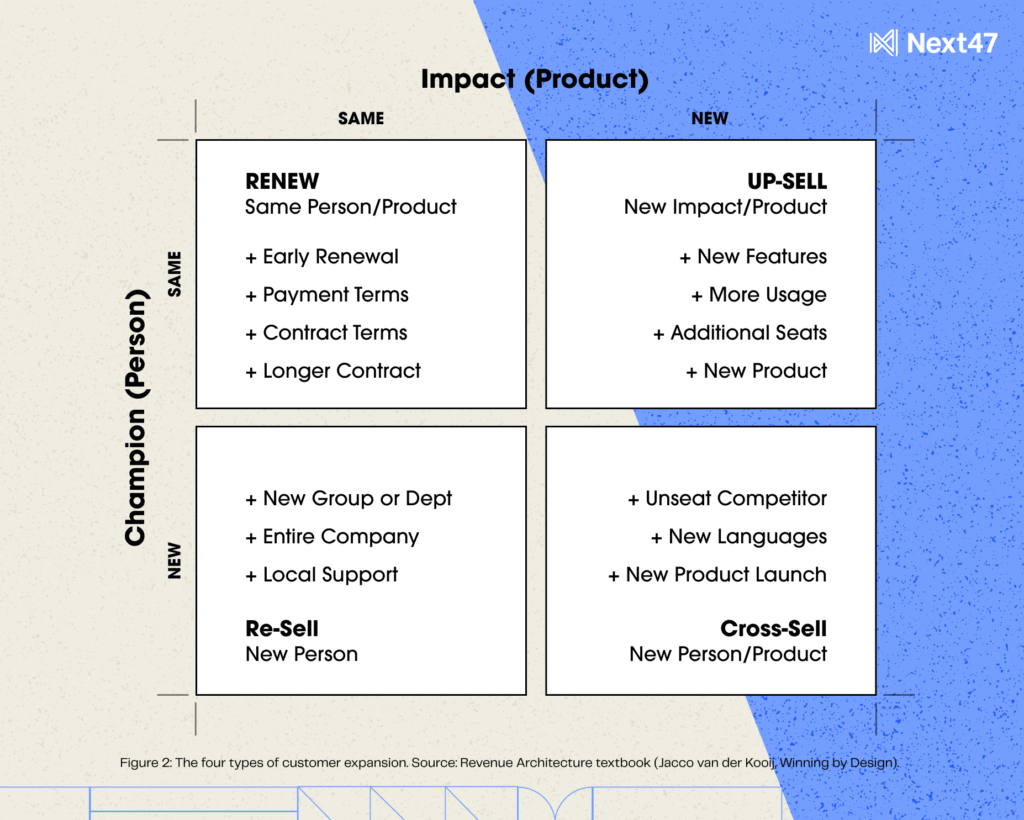In a recurring revenue business, signing the contract is just the beginning. More than seventy percent of your revenue will come after the initial sale, yet most companies spend only $1 on onboarding, retention, and expansion for every $4 spent on customer acquisition. Recurring revenue comes from recurring impact, from the value created when a customer starts using your product. Just because they signed doesn’t mean they’ve seen results yet. That’s where Customer Success (CS) steps in.

It’s the Customer Success team’s job to ensure the customer is properly onboarded, their expectations are met (or exceeded), and they’re getting continuous value from what you sold them. When done right, this creates not just satisfied users, but loyal champions who stick around, spend more, and refer you to other departments and other customers.
Customer Success is essential to compounding that initial win. That’s why CS shouldn’t sit apart from Sales. As presented by the Bowtie Model (see Figure 1), CS is an intrinsic part of the GTM system and should be seen as a core part of the revenue engine, helping uncover and grow new opportunities from within your existing base.
To put this system to work, Customer Success needs to master three key functions: Onboarding, Adoption, and Expansion. In the early days of your startup, one CSM can handle all three functions. As you grow, you will likely have a separate implementation team (onboarding), customer success team (adoption), and account management team (expansion).
Onboarding: The First Value Moment
Onboarding is your customer’s first real experience with your product after the contract is signed. It’s where you turn expectations into action and set the tone for the entire relationship.
Great onboarding ensures that customers:
- Get up and running quickly
- Understand how to use your product
- Achieve their first “aha” moment as fast as possible
What Does Good Look Like?
A smooth handoff from Sales, a clear implementation plan (sometimes referred to as ‘joint impact plan’ to highlight that both customer and vendor have a role to play), proactive support, and time-to-first-value measured in days. If onboarding drags or feels disjointed, that “new customer energy” fizzles out fast.
Common Pitfall
The most common mistake during onboarding is to have a kick-off meeting only with your day-to-day champions. The kick-off is the first time that you sit on the same side of the table as your customer. You have the opportunity to (re-)engage your executive stakeholders and do a deeper discovery, especially of desired value/impact and any critical events or deadlines. The customer will be more forthcoming than during the sales cycle.
Having the executive decision maker there can be used to create urgency and hold the day-to-day project team accountable to deadlines that matter to the internal executives.
Adoption: Delivering Consistent Value
Retention is about making sure customers stick around and achieve the full value of your product. More than that, it’s about keeping them engaged and growing their trust in your product.
Adoption means:
- Solving problems before they become reasons to leave
- Monitoring usage trends to detect churn risks early
- Regular check-ins that are value-focused, not just “touchpoints”
What Does Good Look Like?
High product adoption, low churn, and customers who say, “We couldn’t imagine working without this.” This phase is also where Customer Success acts as the voice of the customer, feeding insights back to product and engineering teams.
Common Pitfall
The most common mistake during the adoption phase is to treat all customers the same, all the time. Instead, segment and prioritize your customers by current and future MRR potential and create high- and low-touch pathways.
For all segments, reduce the number of ‘scheduled check-ins’ and instead opt for fewer, but more meaningful business reviews with executive stakeholders included. At the same time, implement more triggers that could alert you when it’s the right time to pick up the phone and check in with your customer on something bad (churn risk) or good (expansion opportunity) that is happening.
Expansion: Growing from Within
Once your customer sees value, and trust is high, it’s time to expand the relationship. This could mean more licenses, new products, or entering new business units. See Figure 2 below for a simple overview of the different types of expansion possible:
Renew: Renewals often occur on or right before the anniversary of the contract. However, don’t ignore the fact that a customer may be willing to renew nine months into a contract, or a customer who might be willing to switch to a multi-year contract.
Upsell: When your champion at an existing customer buys more services, such as more seats, additional features, or a completely new product, this is considered an upsell.
Resell: When you take the same solution you’ve sold before to a new decision maker in a new geography or department, this is called a resell. It’s much easier than selling to a new customer because you have a relevant internal customer reference to prove your value.
Cross-Sell: When a new decision maker in an existing account needs to be won over to buy a new solution, this is referred to as a cross-sell (new champion/person AND new impact/product). A cross-sell is the most complicated expansion sale.

Expansion involves:
- Identifying growth opportunities based on usage and goals
- Working closely with Account Executives (AEs) to drive upsell
- Building a case for added value—not just asking for more money
What Does Good Look Like?
Account growth that feels natural and earned. When your CS team is in tune with customer priorities, expansion isn’t a pitch—it’s a next step.
Common Pitfall
Most Customer Success teams are pretty good at helping the sales team drive renewals as well as up-sell opportunities. Both of these motions are selling products to the same champion that the CS manager is working with on a regular basis. However, virtually NO CS teams, unless trained and tasked with this explicitly, will do a good job at finding new people or departments to sell your products to. Too many CS managers feel uncomfortable asking their customers, “Who else might benefit from our products and services?”
Metrics & Tools: Driving with Data
As mentioned before, Customer Success should be seen as an intrinsic part of the sales process, not an isolated support function. That means CS teams need to be accountable for revenue, measured like salespeople, and compensated as such, including a commission plan!
Here are the metrics that matter:
- Net Revenue Retention (NRR): The single most important CS metric; tells you how much revenue you’re keeping and expanding
- Gross Retention Rate (GRR): How much revenue you’d keep without upsells
- Churn Rate: How many customers (or how much revenue) you’re losing
- Customer Health Score: A composite of usage, support history, satisfaction, and engagement
- Time to First Value (TTFV): How quickly customers see measurable impact
- Expansion Revenue: Upsell and cross-sell within the base
- Customer Satisfaction (CSAT) and Net Promoter Score (NPS): Sentiment checks that support long-term planning
Tools like Vitally (a customer success platform that tracks customer health in real-time), and even simple dashboards in Salesforce or HubSpot can help CS teams stay proactive, not reactive.
We recommend that you measure ‘Onboarding Retention’ and ‘Adoption Retention’ (also called ‘Ongoing Retention’ separately). Some customers never achieve First Value. ‘Failing to launch,’ which is what onboarding retention measures, is a very different problem from customers who start to use your product and stop, losing trust somewhere along the way. It is not uncommon for most of your churn to be the result of seeds that are planted in the first ninety days of your relationship.
Conclusion
It’s unfortunate that many Customer Success Managers do not feel equipped to engage in sales, and sometimes may even feel the need to protect ‘their’ customers from sales. Since sales is about finding new ways to help customers improve their business, it’s actually a disservice not to tell your customers about other products or services that can help them, or ask who else might benefit from your services. While the sales process should be led by specialized Account Executives or Account Managers, it is CSMs who are in the best position to find expansion leads to pursue.
Remember: the best Customer Success Managers are not just account babysitters—they’re value architects and growth enablers.



